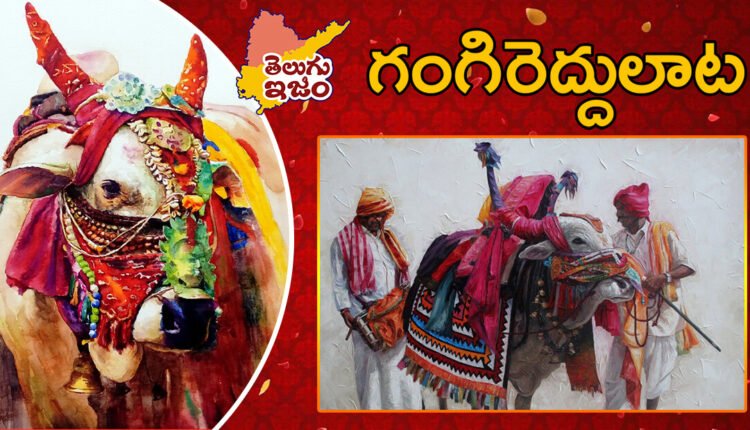Gangireddulatalu : A Prominent Folk Art Form
Gangireddulatalu : An ancient folk art form that is prominent in the Telugu regions. It is associated with the festival of Dhanurmasam. The origin of Gangireddulatalu is traced back to a mythological story. According to the legend, the demon Gajasura performed intense penance to seek Lord Shiva’s grace. Lord Shiva appeared before Gajasura and granted him a boon. Gajasura asked Lord Shiva to enter his womb and be worshipped. Lord Shiva agreed and entered Gajasura’s womb without Goddess Parvati’s knowledge. When Parvati learned about this, she pleaded with Lord Vishnu to free her husband from Gajasura’s womb.
To rescue Lord Shiva, Lord Vishnu devised the Mela (fair) of Gangireddulatalu. Nandi, the vehicle of Lord Shiva, dressed up Kesvara as Gangireddu (a decorated bull) and led the fair with various instruments such as drums, sannai (a wind instrument), trumpets, and hammers. Gajasura requested to witness the performance of Gangireddulatalu. Lord Vishnu, who was waiting for this moment, orchestrated the fair magnificently. Gajasura was pleased with the performance and granted them the boon.
In the meantime, Nandi, who was separated from Lord Shiva, requested Shiva to reunite with him. Deep in thought, Gajasura realized that Lord Shiva, the destroyer of demons, would inevitably slay him. He prayed to Lord Shiva to grant him the honor of having his head worshipped in the three worlds. Lord Vishnu inspired Nandi, and Lord Shiva emerged from Gajasura’s womb in the form of Gajasura, with his horns.
Gajasura’s head was worshipped in all the worlds, and Lord Shiva bestowed Sivaikya (unity with Shiva) upon Gajasura, as he desired. To continue the tradition, Gangireddus (people dressed as Gangireddu) were given instruments and were entrusted to roam the world.
Gangireddulatalu Performances
During Gangireddulatalu performances, various regional folk songs are sung. These include songs dedicated to deities like Sanyasamma, Ramulavari, Easwaramma, Gangaraju, Veera Gunnamma, Malavari Mangamma, and sometimes even popular movie songs. Gangireddulatalu is not limited to Telugu regions alone. Similar traditions exist in the states of Tamil Nadu and Karnataka, although most of them speak Telugu. In Maharashtra, they are known as Nandiwala.
Gangireddus, accompanied by their Gangiredds (decorated bulls), travel from one corner to another in the Andhra region. In the past, kings and zamindars used to organize and entertain Gangireddulatalu in their courtyards. Gangireddus do not have a fixed village and are nomadic during festival days.
On occasions like Sankranti, they visit villages, especially when the farmers have completed their harvest and there are no work songs. In earlier times, male members of the Gangireddu community used to carry Gangireddus through town, while the women sold various items like karakkayas (a fruit), cough medicines, and gilakals (traditional toys) in the villages.
Today, the lifestyle of Gangireddus has undergone some changes. Women wear fancy accessories such as bangles, tilaks, glasses, and pinas (combs). In the past, people used to support Gangireddus by providing them with clothes, allowances, and money, and praising them in the name of their deceased grandparents. Gangireddulatalu performances take place at different locations in villages.
Gangireddus are treated as their own children by their caretakers. They are adorned in various ways, with colorful quilts covering them from the nape to the tail. Their horns are decorated with rings and bright brass tubes with colored woolen threads tied at the end (known as Kuppelu). The mouth is covered with a leather thong, and beautiful leather tufts and shells are tied to the forehead.
The hump is decorated with colored pancha (a cloth) and a garland is placed. They wear a leather belt studded with tin flowers and a shell necklace around the stomach. Their feet are washed, and house owners provide clothes such as sarees and blankets that are worn on Gangireddu’s back. The overall appearance of Gangireddu is similar to that of Nandikeshwara, the sacred bull of Lord Shiva.
Gangi Reddu, the person portraying Gangireddu, wears a Shruti (a musical instrument) and Sannai (a wind instrument) Bura, holds a Dolu (a percussion instrument), and carries a small hand made of bronze. They wear a colorful headscarf, mustache, kamma (an earring) on the ears, and make themselves attractive by wearing an old coat provided by others, a scarf on their shoulders, silver bracelets on their hands, and a bicycle belt with Panganama (a religious symbol) on their foreheads.
Gangireddulatalu performers showcase their skills and entertain people by making loud noises with their instruments. They perform various tricks and games.
Typically, two bulls represent Ramalakshman (characters from the Ramayana), and one cow represents Sita (another character from the Ramayana). The game concludes with the marriage of Sitaram (the bull and cow).
Also Read : Vijayarathashanti : A Celebration During Aging Of Adults With Healthy Life

